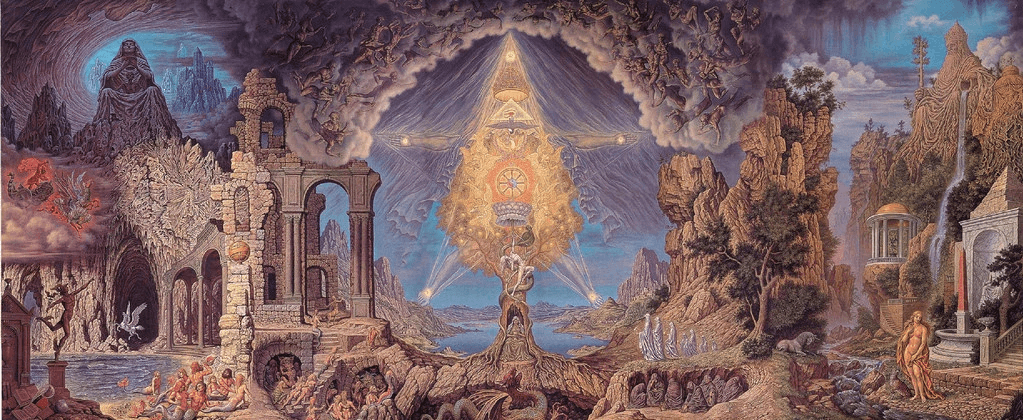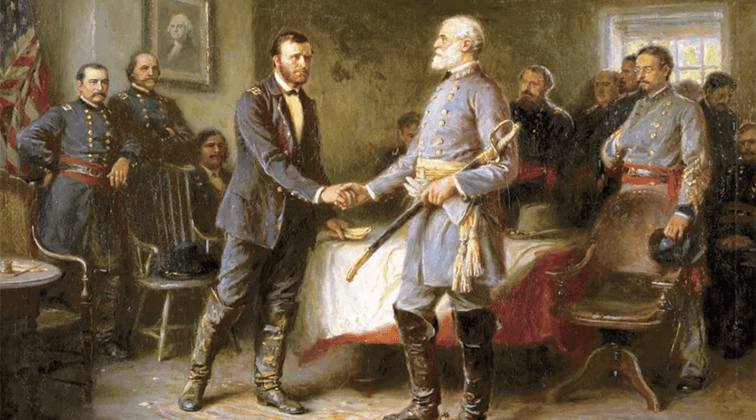Annihilation: A Failed Sci-Fi Adaptation of René Girard

Based on a book by Jeff VanderMeer, the movie Annihilation[1] is a fairly straightforward presentation of the ideas of René Girard. The book is more nuanced and less Girardian, which actually makes it more aesthetically rewarding. It is better that a work of art not be too much a simple application of theory. Even a seeming communist propagandist and partisan like Bertolt Brecht wrote The Good Woman of Setzuan in such a way that it is capable of more than one interpretation. Encyclopedia Britannica states:
“The play is set in China between World War I and World War II. The title character, Shen Te, is a poor but warmhearted prostitute. Because she alone was willing to shelter three gods, they have favoured her with a gift of money. She purchases a tobacco shop but finds that her kinsfolk and other customers take advantage of her kindness. To save her business, Shen Te adopts an alter ego; dressing as a man and acting the role of her tough, pragmatic cousin Shui Ta, she is able to exact just payment. She is forced to assume this role so often that, as Shui Ta, she is accused of murdering Shen Te. In the climactic trial scene, Shui Ta reveals that he and Shen Te are the same person.”[2]
As such, the play is about the dangers of unrestricted handouts, turning relatives and others into dependent, grasping, beggars, bringing out the worst in them. The attempt to profit from the work of others in vampiric fashion ends up killing the golden goose. The feminine urge to look after the lost lamb must be combined with masculine tough love aimed at generating independence and self-sufficiency. Once word gets out to the scroungers, beggars literally line up for their victuals. Communism seems to offer the promise of being taken care of in juvenile manner with peace and wellbeing for all, while in fact producing nothing of the sort. Without the need to look after yourself, workers gradually slide into minimal productivity.
One person, who happens to come from a communist country, however, thinks the play is about the evils of capitalism and how it forces people to be selfish. In a “nice” economic system, the Good Woman could simply keep handing out money and food until all were satisfied, with none having had to work for it. Reading Genesis would seem likely to cure this misperception of reality and the human condition: “Cursed is the ground because of you; through painful toil you will eat food from it all the days of your life. It will produce thorns and thistles for you, and you will eat the plants of the field. By the sweat of your brow you will eat your food until you return to the ground, since from it you were taken; for dust you are and to dust you will return.” (3:17-19) This pro-communist interpretation would be more in keeping with Brecht’s political sympathies, yet it seems strained. Brecht appears to have at least accidentally made a hymn to the free market, yet one of his more famous quotations is “First comes the grub, then morals.”[3] But, since it is stated by a character and not Brecht, it might not represent his own views. Better to have such ambiguity than a simple polemic.
Annihilation, the movie, starts with Lena (Natalie Portman) a biologist and army veteran talking about cancer cells being immortal. She suggests that old age might be regarded as being a defect; an error and genetic mistake that could be cured. But, if the “cure” is cancer, which it would be, it is worse than the disease. Eric Weinstein notes that telomeres exist at the ends of chromosomes. They get shorter as we age, until individual cells are unable to reproduce. This protects us from cancer by putting a limit on cell replication, but it also means that we get old and die. We would live forever without telomeres it would seem, except we would get cancer more frequently and die even sooner. Lab mice have extravagantly long telomeres due to the way they are bred, meaning they get cancer very easily but resist damage to the heart and brain making drug testing on them unrepresentative of drugs’ effects on humans.
Cancer occurs when cells stop doing what the hox genes tell them too. Hox proteins ensure that the correct structures occur in the right part of the body.[4] All cells contain all the genes responsible for every body part, but it is important, for instance, that cells in your ear do not start producing liver cells. As such, cancer represents uninhibited, undirected growth that is pathological and does not partake in the Logos. To exist in a healthy manner is to be limited; to have boundaries. Limitlessness and nondifferentiation is chaos and not order. Freedom of the organism depends on the restriction of the parts of the creature.
In the Shimmer, an area where the laws of nature seem to be suspended in the manner of the Zone in Tarkovsky’s Stalker, all distinctions and differentiations are being eliminated. Like the Zone, the Shimmer is said to be connected to a meteorite. Everything starts to blend together, destroying the identity of the original individuals in the Shimmer. DNA gets mingled between animals and humans and plants, creating monsters. Disorder and border destruction prevails.
At one point, Lena looks at a branch with multiple attractive flowers on it and comments that this kind of mixing would be lethal in a human being.
The Shimmer is a metaphor for the chaos generated by human mimesis. Mimesis is fine except that we also copy each other’s desires. This turns us into rivals. The image is of twin brothers. We become each other’s twin. We reach for the same object simultaneously. You claw at me. I claw at you. Thanks to mimesis, violence generated by rivalry; by competition and resentment/hatred, are ever-present features of human existence.
Near the beginning of the movie, Lena’s husband, Kane, who was part of a Green Beret expedition into the Shimmer, he has unexpectedly turned up again, acting very strangely. The fact that Lena’s husband’s name is “Kane,” together with other indicators, tells us that this movie is explicitly Girardian. The reference is to Cane and Abel who are the archetypal rivals. Cane kills Abel because Abel’s sacrifices are effective since they earn God’s favor and Cane’s are not. Cane resents Abel and resentment entails love and admiration. You want what the other person has, and admire them for possessing what you cherish. Cane wants to be Abel, but he cannot because Abel is already Abel; occupying that position. So, Cane now sees Abel as an obstacle to his own happiness. Cane wants someone else’s being, what Girard calls metaphysical desire, and so he kills Abel, imagining that he can now fill the vacant spot where Abel once was.
Wanting to be someone else is failing to recognize distinctions and differences too. At the end of the movie Kane asks “Am I you or are you me?” He has lost his sense of self-determined individuality and blows himself up with a phosphorous grenade. He finds his loss of identity intolerable. In a way, he is dead already.
When the social structure and hierarchy breaks down, differences are lost and we become rivals. Floods, plagues, fires, pestilence, hurricanes, etc. can also cause the social structure to breakdown, giving rise to looting, murder, anarchy. The more “equal” we are the more we compete. For order to prevail there needs to be hierarchies and differences between animals and people, between parents and children, teachers and students, employers and employees, gods and man, between the police and non-police. This is my wife, not your wife, etc. When children denounce parents, overturning the parent/child hierarchy, as happened in the Chinese Cultural Revolution, things get very ugly very quickly.
In the past, human beings have dealt with mimetic contagion and social dissolution by erroneously blaming a victim for the chaos, though no single individual could ever cause social collapse, uniting by ganging up on him, and killing him. This transforms the war of all against all, to the war of all against one. This creates shared purpose, fellow feeling, and the cessation of mutual hostilities. The first time this occurs, it is spontaneous and by chance. Human sacrifice takes this happenstance and attempts to duplicate it in a controlled and predictable manner, hoping to reproduce the effects of the original murder intentionally; though always dangerous. Once there is an outbreak of violence in primitive societies, without a public justice system, it is hard to stop. On this view, human sacrificed is ritualized scapegoating.
All the women who go into the Shimmer are described as having nothing to lose; no friends and no family. Jessica Jason Leigh, the psychologist, has cancer and will die anyway. One of the women’s daughters has died from leukemia leaving the mother alone and devastated.
Sacrificial victims are historically preferentially chosen from among foreigners, slaves, orphans, POWs, in other words those without friends or families who might decide to seek revenge for the murder of the victim.
The women soldiers are supposed to solve the problem of the mystery and chaos of the Shimmer – as scapegoat victims do for a while. One victim is eaten by a bear creature who then assumes her voice – nixing the human/animal distinction. A crocodile has teeth like a shark – blending land and sea creatures.
Lena discovers the real Kane’s charred body at the lighthouse and then has a faceless, amorphous creature “mirroring” her; copying every movement. It is nightmarish and Lena nearly dies. She tricks the twin into taking a phosphorous grenade, although later it seems that the doppelganger survives, not Lena. Kane had been replaced by his doppelganger. Kane prime asks Lena if she is the real one after Kane prime acknowledges that he is not the original Kane.
The fact that Lena does not even seem to mind that Kane prime is not Kane means she has been infected by the Shimmer, or is herself Lena prime, and does not mind blending the two.
It is not clear how audiences are supposed to figure all this out if they are not already familiar with Girard before seeing the movie. A lot of people find it unintelligible and dissatisfying as made evident by online comments and posts, and its box office failure.
To sum up, evidence for the Girardian interpretation is:
The name “Kane.”
The explicit doubling and mirroring of Lena near the end.
The Shimmer representing the ultimate loss of differentiation – synonymous with social disintegration, death and chaos.
The soldiers all having nothing to lose; no family or friends to go back to – representing scapegoat victims, traditionally used to try to restore order and differences again.




